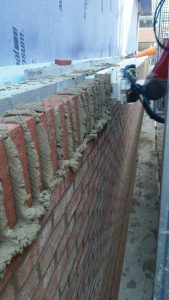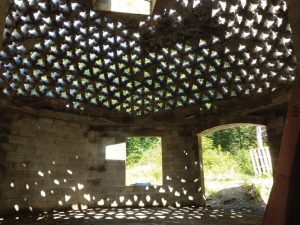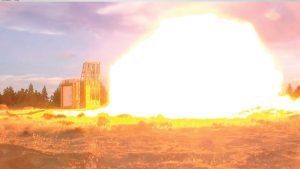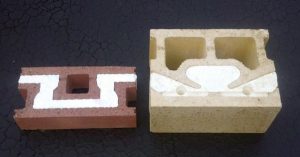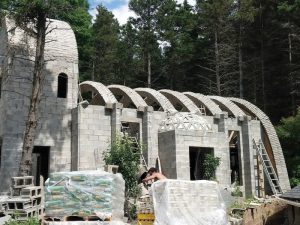What is the future of masonry? Innovation in masonry is critical to meet the growing challenges facing our world. These advancements will create new markets, foster economic growth, and create new green technology. Over the next decade, masonry will evolve into several exciting new hybrid technologies and become a critical part of additive manufacturing. Traditional masonry will be expanded into new design and assembly models, using new materials and green technologies.
Current Trends: Robots
Building Information Modeling for Masonry (BIM-Masonry) is expected to shape the future of design. Buildings will be much more computer-designed, integrated with semi-automated and fully automated assembly methods. Robots are expected to play a significantly more substantial role in assembly in the coming years. Additive manufacturing (3-D printing) will be combining mortar deposition with robotic placement of block in an evolving field of masonry-based additive manufacturing.
The high efficiency of block manufacturing provides an affordable, engineered, finished Concrete Masonry Unit (CMU) with various textures, colors, finishes, and high strength, with tight dimensional control to be used as an element in additive manufacturing (unlike 3-D printing). CMUs are also made in a controlled factory environment, as opposed to on-site 3-D printing. The low cost of concrete block will allow it to win on price in the new realm of additive manufacturing.
3-D printing remains unattractive and unappealing when compared to masonry. Familiarity with masonry will help in the adoption of additive manufacturing innovation because it is based on what is known. This is expected to occur slowly at first, as transitions occur from manual to semi-automated and fully automated assembly. This transition will affect labor and must address the evolving role of labor (e.g., Bricklayers and Allied Craftworkers International Union, BAC).
New Methods
Advances in automated additive assembly, 3-D printing, robotics, and digital design have created a new frontier in masonry innovation. A few companies are leading the way in this growing realm of advanced masonry technology.
- Construction Robotics provides the Semi-Automated Mason (SAM) and the mason’s assistant MULE. The SAM unit uses additive assembly techniques of placing mortar while a robotic arm places block and/or brick in the wall.
- Fastbrick Robotics is a start-up out of Australia. Their Hadrian X masonry robot is capable of building all the vertical walls for a building in a fully automated method. The Fastbrick robotic system requires custom block and uses an adhesive rather than conventional mortar to bind the blocks together.
- Built Robotics is a company dedicated to providing robots for construction. While they do not currently provide a block or brick laying robot, by upgrading off-the-shelf heavy equipment with AI guidance systems, they enable machines to operate fully autonomously.
Exoskeletons
Masonry is strenuous manual labor, and the advances in the arena of exoskeletal technology are very promising. These external support systems will enable today’s masons to keep working and attract young people into the future of the profession. There is a critical shortage of masons nationally, and many of the best are looking toward retirement. Several companies are addressing the challenges created by the demanding nature of masonry work through the research and development of various exoskeletal and other external support system technologies. Levitate Technologies, Inc. Suit X and Ekso Bionics are among the many companies providing various degrees of wearable external body support for workers.
Sustainability and Green House Gases
Masonry innovators have recently found ways for the industry to become much more carbon efficient. Here are three companies leading the way on this front.
- bioMASON is one of the exciting recent technology innovators in this area. This start-up has found a way to dramatically reduce the carbon footprint of Portland cement by using bacteria to grow calcium carbonate crystals to replace the carbon-intensive process of Portland cement manufacturing needed to produce standard concrete and concrete block.
- Solidia Technologies is a company developing a lower carbon footprint than Portland cement for concrete through its methods of cementing concrete together by using innovative chemical cements and curing approaches.
- CarbonCure seeks to reduce the carbon footprint by pumping liquid CO2 into concrete and CMU through the mixing process.
New Applications
The versatility of masonry creates new design possibilities, including water storage, septic tanks, ships, boats, vessels, barges, bridges, seawalls, levees, flood protection infrastructure (culverts, etc.), and more. The use of CMU’s to build roofs, including arches, domes, and flying buttresses, is another new application for manufactured concrete block (this includes work by the author). The use of fiber reinforced plastic (FRP) rebar creates rust proof reinforced masonry and concrete, which will become increasingly significant as sea levels are expected to rise. These new applications for masonry are expected to grow the industry significantly by creating entirely new markets.
New Materials
Ductile and elastomeric composite material create masonry appropriate for blast and ballistic applications, defense applications, hardened structures, seismic applications, and severe weather events. ProtectiFlex provides a proprietary technology combining recycled non-biodegradable material, composite fibers, and/or rebar in a cement matrix. This material offers protection against blast, ballistic, forced entry, impact, fire, and seismic loads, and can be used to mitigate risk against accidents, natural disasters, and direct attacks. This material design prevents bullet penetration, reduces spalling, and can absorb large amounts of energy without diminishing structural integrity. It has 20 times the strain capacity of traditional concrete before failure.
Autoclaved aerated concrete (AAC) is another newer material that holds promise due to its light weight and ease of cutting. Aercon provides AAC material in both blocks and panels. This material is lightweight, can be for both load-bearing and non-load bearing applications, has good acoustic performance, offers better thermal insulation than standard concrete, and includes many of the benefits of standard concrete such as fire safety, insect and pest resistance, and durability.
Insulated concrete blocks are also relatively new to the marketplace and help to maximize the thermal mass benefits of concrete and masonry, creating more thermally efficient buildings. NRG Block makes thermally insulated CMU’s which have a serpentine interlocking expanded foam thermal insert within the block. This design creates an insulated block with no direct thermal bridging from the inside of the building to the outside, resulting in a better thermally insulated building envelope. From both inside and outside, the wall looks like a conventional block wall.
Light-transmitting or translucent concrete and mortar are yet another new addition to the palette of masonry materials. Fiber optic cables are cast into concrete, allowing light to pass through dense opaque concrete and/or mortar, creating visually compelling architectural lighting effects. Litracon produces light-conducting concrete material for construction applications. The company uses both glass fiber optic elements, with a more randomized distribution of light-conducting elements cast in concrete, and a plastic light-conducting grid which creates regularly spaced light-conducting elements, appearing like LED pixels in a concrete grid. Light Transmitting Mortar is a start-up using technology similar to that found in light-conducting concrete, except that the light-conducting fibers are made of plastic. This creates a unique visual effect by allowing mortar joints to transmit light from outside to inside (or vice versa).
What was the Vision of the Future 30 Years Ago?
This question was posed by a Workshop on Masonry sponsored by the National Science Foundation (NSF) to a steering committee led by Clayford T. Grimm in 1988. Committee members included the National Concrete Masonry Association (NCMA), the Masonry Institute of America (MIA), and Clemson University. Here are the findings of the Grimm’s steering Committee from 1988, “Why Are There So Few Innovations in Masonry?”
- Tort Law
- Bureaucratic Building Code Process
- Unfunded Process of Writing Consensus Standards
- Industry Fragmentation: “Economic pressures for fast construction time leave little time for the learning curve required by new ideas. The construction industry mindset supports the status quo.”
- Research Fragmentation
- Educators teach what they know (few know masonry)
- Designers are reluctant to use masonry structurally because of poor jobsite quality control
- Academicians who dream up new names for old ideas and make a career out of it.
- Designers who do not care about mason productivity.
- Lack of financial incentive.
This question persists over 30 years later. The author has encountered the following responses from industry, trade groups, and end-users over the years: “it is a mature technology” and “there is no room for improvement after thousands of years of masonry practice.” Much contemporary research looks back in time to understand some of humanity’s achievements with masonry (for example, the work done by Jacques Heyman). Old ideas are often presented as “new,” including, for example, Catalan arches, which originated in the 14th century around Valencia, Spain. Guastavino tile arches from the 19th century (Catalan arches) are also reexamined and often presented as new. This illustrates novelty versus innovation, as described by Loreto et al. in the ‘adjacent possible’ scheme.
What is the Vision for the Future Today?
Expect an increase in the automated assembly of buildings, gradually moving from worker’s exoskeletons to semi-automated systems to fully automated robotic assembly of masonry. Expect the use of greener materials, new technologies, and methods to reduce carbon emissions. Expect new designs and forms from the CMU as designers continue to utilize its strength and value. Expect stronger, safer, more energy-efficient, affordable, beautiful masonry buildings.
Prediction
Green masonry will become central to additive manufacturing. It is environmentally appropriate, economical, attractive, and builds on what is known. This prediction calls for a productive future for the masonry industry in which successful innovation will occur as creative ideas exist in a balance between the familiar and the new.■
About Innovation
- Both large and small teams are necessary for success. Small teams are known for disruptive work and large teams for developing work; together they create the right conditions for innovation. Large teams develop and small teams disrupt science and technology (L. Wu, 2019)
- Creativity requires isolation. How do people get new ideas? (Isaac Asimov, 1959)
- Revolutionary innovation typically comes from last born children among siblings (this does not pertain to single children). Born to Rebel (Frank Sulloway, 1996)
- Tie between autism and innovation, due to the ability to focus on a problem. Die Autistischen Psychopathen im Kindesalter [Doctoral Thesis] (Hans Asperger, 1944)
- Real progress in science comes more from revolutions, and less from incremental change. The Structure of Scientific Revolutions (Thomas Kuhn, 1962)
- “Adjacent possible” helps predict innovations to come. Adjacent Possible (Stuart Kauffman, 2003)
Sources of Innovation
- Active research is the focused, linear approach toward solving a problem, typically performed by larger teams. For example, Code development for seismic masonry applications.
- An interdisciplinary approach involves a hybridization, involving other fields providing new perspectives. An example is 3-D printing with manufactured concrete block included as an element in additive manufacturing.
- Biomimicry looks to nature for design concepts, as inspection of those pesky sticking burdocks being the inspiration for VelcroTM.
- “Out of Nowhere” invention occurs through an apparently unexpected genesis, as if a door opens to the innovator. This process is informed by what is known, it favors the curious.
- Uncovering something – as opposed to pure invention – involves a detailed and systematic analysis of the field, which might lead to a useful scientific or mathematical discovery.

